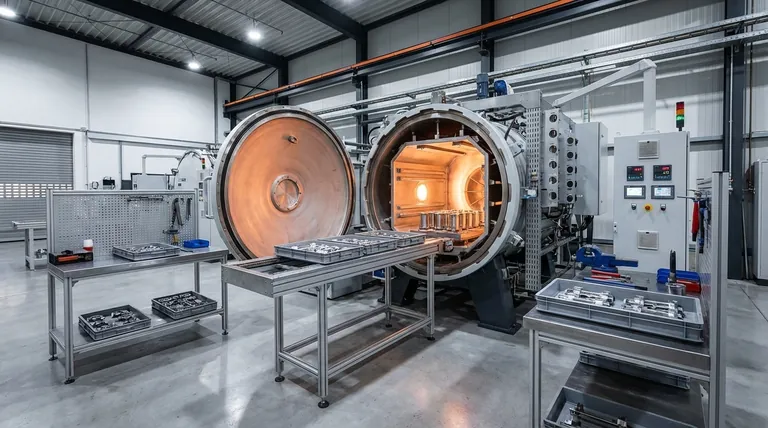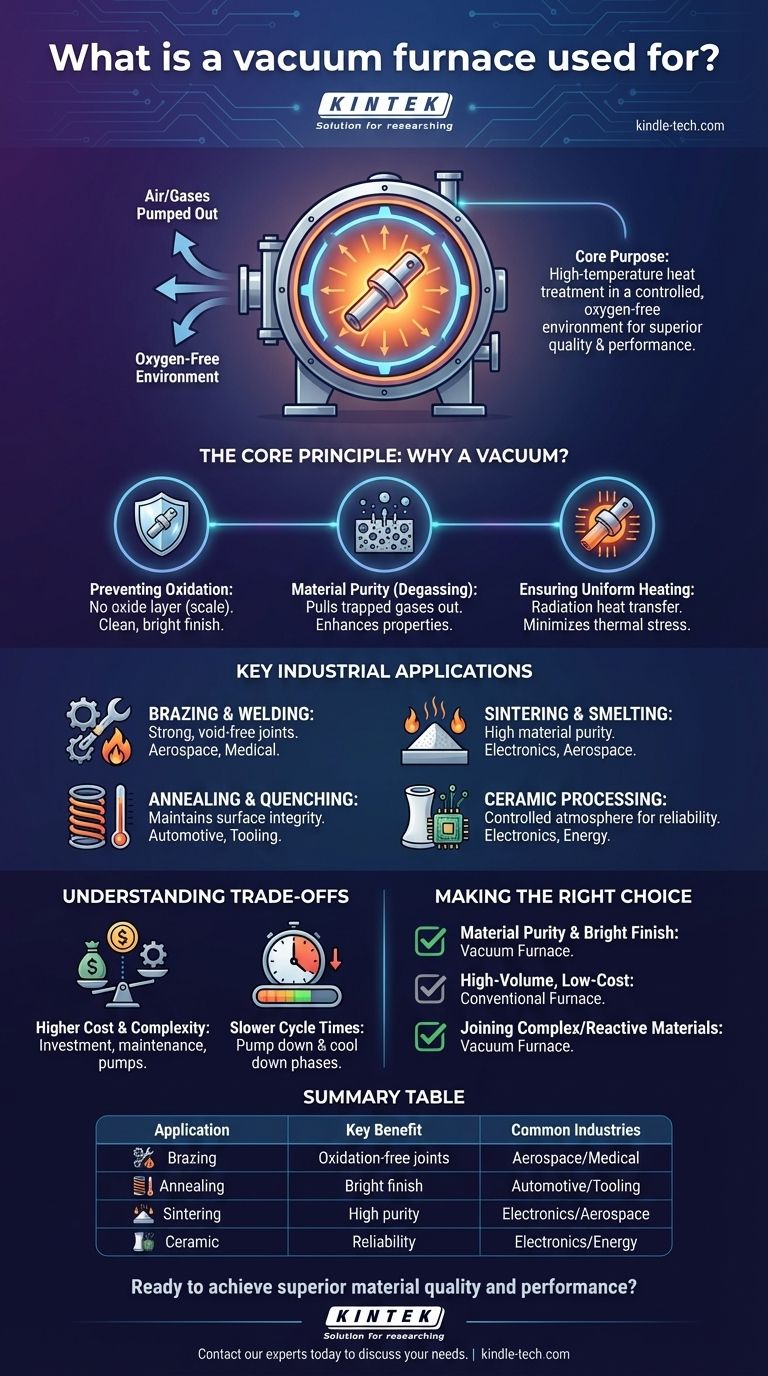In essence, a vacuum furnace is a specialized piece of industrial equipment used for the high-temperature heat treatment of materials in a controlled, oxygen-free environment. Its primary applications include brazing, sintering, annealing, and smelting metals and ceramics, where preventing oxidation and ensuring material purity is critical for achieving superior quality and performance.
The core purpose of a vacuum furnace is not just to heat materials, but to do so in an environment free from atmospheric gases. By removing oxygen and other reactive elements, it enables thermal processes that would be impossible in a standard furnace, resulting in cleaner, stronger, and brighter finished parts.

The Core Principle: Why a Vacuum?
A standard furnace heats materials in the presence of air, which contains about 21% oxygen. At high temperatures, this oxygen readily reacts with most materials, causing undesirable effects. A vacuum furnace solves this by first pumping out the air before the heating process begins.
Preventing Oxidation and Contamination
The most significant advantage is the prevention of oxidation. Without oxygen, metal parts can be heated without developing a layer of oxide (scale) on their surface.
This results in a clean, bright finish that often eliminates the need for post-processing cleaning or grinding.
Achieving Material Purity (Degassing)
The vacuum environment actively pulls trapped gases out of the material itself, a process known as degassing.
This is crucial for applications in electronics and aerospace, where the purity of the material directly impacts its electrical or mechanical properties.
Ensuring Uniform Heating
In a vacuum, heat is transferred primarily through radiation, which provides highly uniform and consistent heating across the entire part.
This uniformity minimizes thermal stress and distortion, which is essential when working with complex geometries or sensitive materials.
Key Industrial Applications
The controlled environment of a vacuum furnace makes it indispensable across numerous advanced manufacturing and research sectors.
Brazing and Welding
Vacuum brazing is used to join components without melting the base metals. The vacuum prevents oxidation, allowing the brazing alloy to flow cleanly and create exceptionally strong, void-free joints.
This is a standard process for manufacturing critical components in the aerospace and medical industries.
Annealing and Quenching (Heat Treating)
Annealing (softening) and quenching (hardening) are fundamental heat treatments. Performing them in a vacuum maintains the part's surface integrity and metallurgical properties without discoloration or decarburization.
The result is a finished part with the desired mechanical characteristics and a bright, clean surface.
Sintering and Smelting
Sintering is the process of fusing powdered materials together with heat. A vacuum ensures the particles bond cleanly without forming unwanted chemical compounds.
Similarly, vacuum smelting is used to refine metals to a very high degree of purity by removing gaseous impurities at high temperatures.
Ceramic Processing
High-purity ceramics are often fired in a vacuum to achieve specific properties and to ensure a strong bond when sealing ceramic components to metal parts. The controlled atmosphere is critical for the final product's reliability.
Understanding the Trade-offs
While powerful, a vacuum furnace is a specialized tool that is not universally applicable or without its own set of challenges.
Higher Initial Cost and Complexity
Vacuum furnaces are significantly more complex than their atmospheric counterparts, involving vacuum pumps, sophisticated control systems, and robust chamber designs. This leads to a higher initial investment and maintenance overhead.
Slower Cycle Times
The need to pump down the chamber to the required vacuum level before heating and then backfill it with an inert gas for cooling adds time to the overall process. This generally results in longer cycle times compared to conventional furnaces.
Making the Right Choice for Your Goal
Selecting the correct thermal processing environment depends entirely on the required outcome for your material or component.
- If your primary focus is material purity and a bright finish: A vacuum furnace is the ideal solution for preventing surface oxidation and contamination.
- If your primary focus is high-volume, low-cost processing of non-reactive materials: A conventional atmospheric furnace is often more efficient and economical.
- If your primary focus is joining complex or reactive materials: Vacuum brazing provides a superior, high-strength joint that cannot be achieved in a normal atmosphere.
Ultimately, choosing a vacuum furnace is a decision to prioritize material quality and final-part performance above all else.
Summary Table:
| Application | Key Benefit | Common Industries |
|---|---|---|
| Brazing & Welding | Oxidation-free, high-strength joints | Aerospace, Medical |
| Annealing & Quenching | Bright finish, no decarburization | Automotive, Tooling |
| Sintering & Smelting | High material purity, degassing | Electronics, Aerospace |
| Ceramic Processing | Controlled atmosphere for reliability | Electronics, Energy |
Ready to achieve superior material quality and performance?
Your projects demand precision and purity. KINTEK specializes in advanced lab equipment, including vacuum furnaces, to meet the exacting needs of laboratories in aerospace, medical, and electronics manufacturing. Our solutions ensure oxidation-free heat treatment for brighter finishes, stronger joints, and higher material purity.
Contact our experts today to discuss how a KINTEK vacuum furnace can enhance your thermal processing capabilities and deliver the superior results your work requires.
Visual Guide

Related Products
- Vacuum Heat Treat Furnace with Ceramic Fiber Liner
- Vacuum Heat Treat Sintering Brazing Furnace
- Vacuum Heat Treat Furnace and Levitation Induction Melting Furnace
- Molybdenum Vacuum Heat Treat Furnace
- Vacuum Heat Treat and Molybdenum Wire Sintering Furnace for Vacuum Sintering
People Also Ask
- What is the standard thickness of plating? Optimize Durability, Corrosion & Cost
- What materials are used in a vacuum furnace? A Guide to Hot Zone Materials and Processed Metals
- What is a vacuum furnace used for? Unlock Purity in High-Temperature Processing
- What is the leak rate for a vacuum furnace? Ensure Process Purity and Repeatability
- What are the advantages of a vacuum furnace? Achieve Superior Purity and Control in Heat Treatment



















